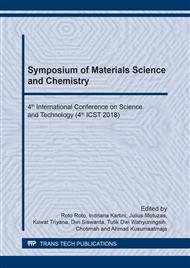p.120
p.127
p.133
p.140
p.146
p.153
p.159
p.169
p.175
The Revised Method of Quantitative Detection of Animal-Origin Bovine and Porcine Gelatin Difference Using Surface Plasmon Resonance Based Biosensor
Abstract:
We have previously reported the surface plasmon resonance (SPR)-based biosensor ability for quantitatively differentiating bovine and porcine gelatin has been done by us before. However, it has some inaccuracies. By improving the method of detection, the results of this study shows that the difference between bovine and porcine gelatin was more distinguishable. The sensor response models acquired were nonlinear as in the previous study. However, they show different characteristics. The sensitivities of the sensor obtained are higher than those of the previous ones, i.e., 3.04o and 4.29o for bovine and porcine gelatin concentration change of 0.1%, respectively. And the sensor’s LOD and LOQ towards both gelatin concentrations were 0.22% and 0.74% (w/w), respectively.
Info:
Periodical:
Pages:
146-152
Citation:
Online since:
March 2019
Authors:
Price:
Сopyright:
© 2019 Trans Tech Publications Ltd. All Rights Reserved
Share:
Citation:


